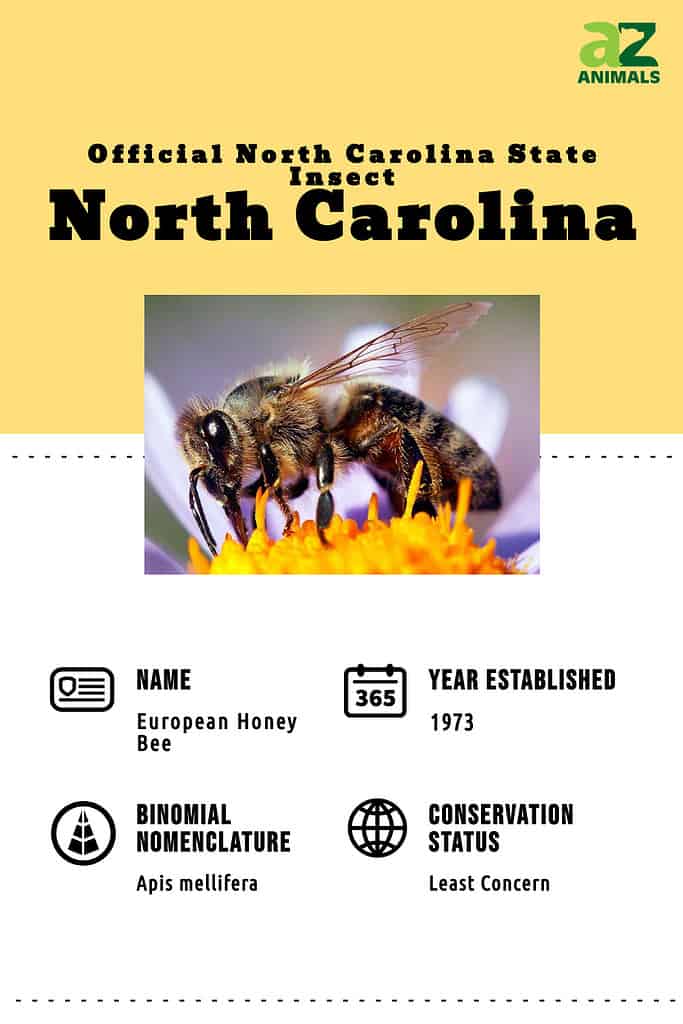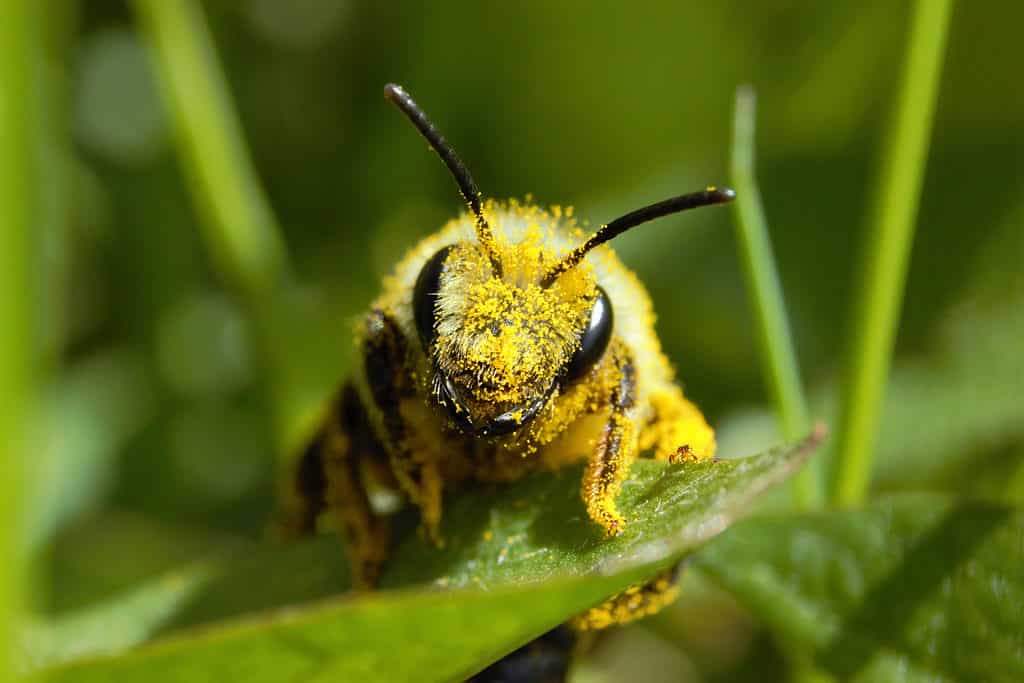Have you ever been asked to name a state bird, state insect, state dog, state flower, or state fish? These refer to the specific state official symbol in the given category. Cultural traditions, native plants, and common animals are sources of many states’ official symbols.
The official North Carolina state insect is the European honey bee, Apis mellifera, also called the western honey bee.
Learn more about this beneficial stinging insect and why we attach so much value to honey bees in North Carolina.
North Carolina State Insect
North Carolina General Assembly became the first to claim the European honey bee as its state insect in 1973. The insect’s key role as a pollinator is globally recognized, and 16 other states claim the insect as theirs. However, the state insect is just one of North Carolina’s official symbols.

The western honey bee is native to Europe, Africa, and the Middle East. There are 20 subspecies (races) known, and none are native to the United States.
However, the distribution of subspecies of the western honey bee is wide globally beyond their native range. The bee species introduced by settlers in America dates back to early 1622.
Description and Appearance
European honey bees are social insects and live in colonies of 10,000 bees. In the wild, European honey bees live mostly in hollow cavities of trees and can also be seen coalescing on a tree branch during swarming seasons.
Honey bees are Hymenoptrerans, and their sex is determined in a haplodiploid way. Unfertilized eggs develop into drones (males), while the fertilized eggs hatch into females. The female larvae may mature into a queen or a worker bee, depending on the feeding program. Female larvae mature into queens by eating a rich diet of nectar, pollen, and royal jelly.
However, a standard diet of brood food, nectar, and pollen turns the female larvae into worker bees.
Differences Between European Honey Bee Castes:
Worker Bees
Worker bees don’t lay eggs and are the smallest physically of the three castes at a length of ½ inch long. They are the commonest bees you see outside gathering nectar and pollen or guarding a hive. On both their hind legs, they have a pollen sac known as a corbicula for carrying the gathered pollen.
European worker bees’ abdomen end is sharp-pointed and produces wax scales on the underside. The scales help to build the honeycombs in a hive. These workers have a barbed stinger carrying a poison sac. When they sting a tough-skinned animal, the sting is torn from the end of their abdomen, resulting in the worker bee’s death.
Drones
Drones are a hive’s male caste. They are larger than the worker bees, and their body parts appear broader. Drones have thick abdomens with blunt ends.
As males, their only work is to mate with the virgin queen, and they can’t offer protection to the colony because they are stingless.
Queens
A queen bee looks much like an enlarged worker bee. However, her abdomen is longer and more rounded. The queen bee also has a stinger with fewer barbs, which she rarely uses. However, she can sting and survive.
Life Cycle of European Honey Bee
From the egg, honey bee metamorphosis undergoes a complete cycle. It means that bees have four distinct developmental stages. The egg hatches into larvae, which develop into pupae and then an adult bee. The development of an egg into adulthood depends on the caste.
Queens develop fastest within 15 -16 days, workers take 21 days, while drones mature slowest (24 days).
Eggs
Honey bee eggs appear like tiny grains of rice measuring 1 to 1.5 mm long. After mating and when the time is right, the queen lays one egg in each hexagonal cell in the comb on the brooding side. The queen can lay up to 3,000 eggs in a day.
The eggs incubate for three days before hatching into larvae. Although honey bee eggs are difficult to see on a comb, they help commercial beekeepers determine whether their hives have a lying queen.
Larvae
When the eggs hatch into larvae, the comb cells are open. This is why we refer to them as “open brood.” You can observe the white C-shaped larvae at the bottom of the brooding wax comb. Larvae maturity also depends on the caste (queen: five days, workers: six days, drones: just over six days).
Upon maturity, the larvae extend upright in the individual cell. At this stage, worker bees tending the brood cover the individual cells containing the prepupal with wax.
Pupae
Under the wax covering, the prepupal larvae develop into pupae. The pupae remain under the seal until they molt into adults. Upon becoming mature adult bees, they break the seal using their mouth to get out.
A pupae brood is known as a “capped brood” because of the wax sealing on the cells. As mentioned earlier, different honey bee caste members mature differently, and the same applies in the pupae stage (queen: eight days, workers: 12 days, drones: 14.5 days).
Adults
Adult European honey bees are hairy and have three body parts: head, thorax, and abdomen. The main features of their head are a pair of antennae and compound eyes.
They have two wings and three pairs of legs attached to their thorax. The honey bee abdomen consists of two segments separated by a waist constriction.
Reproduction
Honey bees are highly social, making their colonies like one super-organism. It means a colony is a biological unit. No bee leads a solitary life; different castes depend on each other for survival and continuity.
Bees create new colonies by swarming. European honey bees swarm in the early summer or spring when flowers bloom. As the number of bees increases in the hive and there is the need to divide, the swarming process starts.
First is the incubation of 10 to 20 fertilized eggs for queens. When the daughter queens reach their pupae stage, the mother queen plus two-thirds of the mature worker bees leave the original colony. The migrating bees travel, seeking new territory to establish a hive.
During the expedition, the honey bees search for a secure place to coalesce, usually on tree branches. When the bees are coalescing, scout workers embark to seek a habitable place where they can hive. An example is a hollow tree cavity.
As the daughter queens emerge as adults in the original colony, they fight until only a single survivor remains. If one queen matures before the rest, she will hunt down the other unborn siblings and kill them.
After some time and maturity, the emerging new queen searches for drones from other colonies to mate with. She will require mating with about 15 drones in the first two weeks of life. Honey bee queens have a spermatheca for storing the collected sperm throughout their entire life.
Bee mating happens outside the hive in the air where drones congregate. Upon successful mating, the daughter queen can start laying eggs, thus completing the remaining colony.
Temperate climates limit swarming to once a year because pollen and nectar season only lasts a few months. However, in the tropics, honey bees swarm more than once yearly.
The Importance of European Honey Bees In North Carolina
The European honey bee insects play a key role in the environment and have many economic benefits.
Pollination
As the western honey bee collects nectar from flowers, it helps transfer pollen to the stigma for fertilization. The process helps both agricultural and wild plants sire the next generation.

Bees helps transfer pollen to the stigma for fertilization. The process helps both agricultural and wild plants sire the next generation.
©David James Chatterton/Shutterstock.com
An example of the importance of honey bees in pollination is in regard to cucumbers. North Carolina is among the leading producer of cucumbers. According to North Carolina State University studies, cucumber flowers require high insect visitation traffic for good pollination.
Food Production
Bees make honey from the collected nectar, a natural sweetener. The history of using honey directly as food and an ingredient when making other foods dates back thousands of years.
Other Beehive Products
Bee farmers can harvest other products from their apiaries, including beeswax, bee pollen, and royal jelly. These are beneficial in many ways.
Beeswax uses include making candles, shoe polish, and cosmetics. Royal jelly makes cosmetics, while bee pollen is a protein source.
Besides providing us with honey and pollinating crops, bees are good crop protectors against invaders. Most animals fear their sting, including large herbivores. In Africa, for example, the beekeeping project is proving successful against elephant invasion. Additionally, it is economical for locals bordering parks and forests where these tusked mammals live.
Threats Facing Honey Bees
In the recent past, the population of bees has been declining due to several threats. The threats facing bee colonies include:
- European bee eaters
- Varroa mites, which affect the microbiome of honey bees
- Natural habitat destruction, which forces the bees to migrate in search of food
- Harmful pesticides, which expose all types of bees to toxic chemicals. A single incident of pesticide exposure can lead to decimation, thereby wiping out a whole colony.
Luckily, some people are voicing the benefits of these insects in our society and promoting their conservation. Governments are also enacting laws prohibiting known pesticides that negatively affect honey bees.
Where Can I Get Help on Beekeeping In North Carolina?
- The County Cooperative Extension Agent
- North Carolina State Beekeepers Association
- Extension Apiculturist at the N.C. State University
- North Carolina’s Department of Agriculture
The photo featured at the top of this post is © SanderMeertinsPhotography/Shutterstock.com
Thank you for reading! Have some feedback for us? Contact the AZ Animals editorial team.







